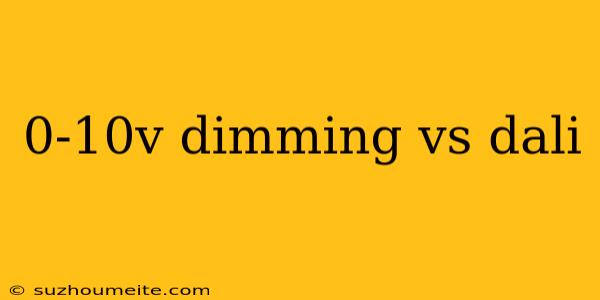0-10V Dimming vs DALI: Understanding the Differences
In the world of lighting control, two popular protocols have emerged as leading contenders: 0-10V dimming and DALI (Digital Addressable Lighting Interface). Both technologies have their strengths and weaknesses, and understanding the differences between them is crucial for making informed decisions when designing and installing lighting systems.
0-10V Dimming
0-10V dimming is a popular and widely used protocol for controlling lighting levels. It works by varying the voltage supply to the light source, typically between 0 and 10 volts, to achieve the desired level of brightness. This protocol is commonly used in conjunction with analog dimmers, which are simple and relatively inexpensive.
Advantages of 0-10V Dimming
- Simple and cost-effective: 0-10V dimming systems are relatively inexpensive and easy to install.
- Wide compatibility: Most dimmable ballasts and LED drivers are compatible with 0-10V dimming.
- Easy to commission: No complex programming or setup required.
Limitations of 0-10V Dimming
- Limited flexibility: 0-10V dimming systems can only control lighting levels, not other parameters such as color temperature or color.
- No feedback: The system does not provide feedback on the actual lighting level or status of the luminaire.
- Limited scalability: 0-10V dimming systems can become cumbersome and difficult to manage in large installations.
DALI (Digital Addressable Lighting Interface)
DALI is a digital protocol that allows for more advanced and sophisticated control of lighting systems. It uses a two-wire bus to communicate between devices, enabling multiple luminaire types to be controlled and monitored simultaneously. DALI is commonly used in commercial and industrial applications where precise control and monitoring are critical.
Advantages of DALI
- Advanced control: DALI enables control of multiple parameters, including lighting level, color temperature, color, and more.
- Feedback and monitoring: DALI systems provide real-time feedback on the status and performance of each luminaire.
- Scalability: DALI systems can be easily scaled up or down depending on the requirements of the installation.
- Increased energy efficiency: DALI systems can optimize energy usage by sensing occupancy and adjusting lighting levels accordingly.
Limitations of DALI
- More complex installation: DALI systems require ahigher level of technical expertise and may require additional infrastructure.
- Higher cost: DALI systems are generally more expensive than 0-10V dimming systems.
- Limited compatibility: Not all luminaire types are compatible with DALI protocol.
Comparison of 0-10V Dimming and DALI
| Parameter | 0-10V Dimming | DALI |
|---|---|---|
| Control Type | Analog | Digital |
| Scalability | Limited | High |
| Flexibility | Limited | Advanced |
| Feedback | None | Real-time |
| Cost | Low | High |
| Complexity | Simple | Complex |
In conclusion, 0-10V dimming and DALI are two distinct protocols with different strengths and weaknesses. While 0-10V dimming is a simple and cost-effective solution for basic lighting control, DALI offers advanced control, feedback, and monitoring capabilities that make it an ideal choice for more complex and demanding applications. Ultimately, the choice between 0-10V dimming and DALI depends on the specific requirements of the installation and the level of control and sophistication needed.
